“Because a scar means you survived. It means you’re tough and hard to kill. It means you lived.” These words found me at 3:17 AM last Tuesday, glowing faintly on my phone screen while the rest of the world slept. The crack running across my bedroom ceiling – the one I’ve stared at through countless sleepless nights – suddenly looked less like a flaw in the plaster and more like a roadmap of survival.
There’s a particular heaviness to 3 AM thoughts. The kind that makes your chest feel like it’s lined with lead while your mind races through every ‘what if’ and ‘if only.’ Maybe you know this feeling too – that moment when the weight of starting over seems impossible because ‘again’ implies you’ve already failed once. How do you begin when everything feels broken?
I used to hide my scars, both the visible ones from childhood accidents and the invisible ones from emotional tumbles. We’re taught to cover our cracks, to present seamless versions of ourselves to the world. But here’s what three years of therapy and seven notebooks filled with midnight thoughts have taught me: those marks aren’t evidence of damage. They’re proof of repair.
The Japanese art of kintsugi repairs broken pottery with gold lacquer, treating breakage as part of an object’s history rather than something to disguise. There’s profound beauty in that philosophy – the understanding that being broken doesn’t diminish value; the repair itself becomes part of the story. Your scars, whether from childhood surgeries or heartbreaks that left no physical mark, follow the same principle.
Right now, you might be measuring your worth by how intact you appear. Comparing your behind-the-scenes to everyone else’s highlight reels. Watching strangers laugh on subway platforms while you’re counting the minutes until you can reasonably go back to bed. I’ve been there too – sitting perfectly still in public places while feeling like I’m coming apart at the seams.
But here’s what they don’t tell you about starting over: it’s not about erasing what came before. The most powerful rebuilds incorporate the rubble. That relationship that ended in flames? It taught you boundaries. The job loss that shattered your confidence? It redirected you to something better suited to your gifts. Even the childhood wounds you thought you’d buried – they’re the reason you notice when others hurt.
Tonight, if you’re reading this through tired eyes, if your ‘starting over’ feels more like crawling than running, remember this: survival isn’t a straight line. Some days healing looks like getting out of bed; other days it’s letting yourself stay there. Both count. Your scars – all of them – are receipts proving you’ve paid life’s toughest dues. And the beautiful things waiting ahead? They’re not consolation prizes. They’re what you’ve been surviving toward.
They have always been meant for you.
Scars: The Language of Survival
Lena’s fingers traced the raised contours along her forearm as she mixed cadmium red with titanium white. The paintbrush trembled slightly – not from pain, but from the quiet exhilaration of transforming what surgeons called “residual scarring” into something breathtaking. Her latest canvas depicted a phoenix emerging from what appeared to be golden cracks, the textured strokes mirroring the very scars that once made her avoid mirrors. “Every ridge tells a story my lips couldn’t,” she’d later explain at her gallery opening, watching attendees unconsciously touch their own hidden marks.
The Biology of Resilience
What Lena instinctively understood aligns with fascinating science. When skin repairs itself after injury, collagen fibers reorganize with 20% greater density than undamaged tissue – nature’s reinforcement for future protection. Dr. Alicia Monroe’s dermatological studies reveal that healed wound sites demonstrate remarkable adaptability, developing enhanced nerve sensitivity and blood flow. This biological wisdom translates metaphorically to emotional recovery; our psyche’s equivalent of collagen manifests as:
- Adaptive coping mechanisms (e.g., Lena’s artistic expression)
- Heightened emotional awareness (those “trigger points” becoming growth compasses)
- Increased capacity for empathy (scar tissue as emotional bandwidth)
Your Scar’s Secret Narrative
Consider the oldest scar on your body right now. The childhood bicycle mishap. The kitchen knife slip during college meal prep. That surgical incision you rarely discuss. Each represents what researcher Brené Brown calls “a map of survival” – physical evidence you navigated pain and kept living.
“Touch that scar now,” I’ll often suggest in workshops. “Does it feel warmer than surrounding skin? That’s your body still sending reinforcements to what it remembers as vulnerable territory. What if we treated emotional scars with the same ongoing care?”
From Wounds to Wisdom
Three ways to reframe your scars this week:
- The Museum Approach
Treat marks as exhibits in your personal history museum. That knee scar? Gallery 1: “Age 8 – Learned Gravity Exists.” The faded burn on your wrist? Wing 3: “Proof I Survived My First Apartment Cooking Phase.” - Sensory Anchoring
When self-doubt arises, press gently on a visible scar. The tactile feedback interrupts negative thought loops with concrete evidence: This body has healed before. - Symbolic Repurposing
Like Lena’s paintings, transform scars into creative metaphors. A client once drew her C-section scar as a “moon landing site” where her daughter first touched Earth.
“Scars are tattoos with better stories,” joked a veteran at Lena’s exhibit. But perhaps they’re more – biological bulletins that whisper You adapted. You’re adapting still.
The Weight No One Sees
There’s a particular kind of exhaustion that doesn’t show up in blood tests or sick leave forms. It’s the type that settles deep in your bones during another endless Zoom meeting, where you pinch your own forearm under the desk just to stay present—just to prove you’re still capable of feeling something. This is the reality for so many of us carrying invisible weights, performing wellness while running on empty.
The Performance of Being Okay
Consider this anonymous confession from a reader we’ll call Jamie: “I perfected the art of the muted cry during board meetings. While nodding at quarterly reports, I’d dig my nails into my palm until the physical pain drowned out the screaming in my head. The terrifying part? No one ever noticed.”
This phenomenon has clinical names—”smiling depression,” “high-functioning anxiety”—but what they all describe is the brutal disconnect between external competence and internal collapse. Psychologists note these conditions often go undiagnosed because sufferers maintain surface-level normalcy: showing up to work, remembering birthdays, even cracking jokes—all while privately drowning.
The Two Versions of You
| The You Everyone Sees | The Real You |
|---|---|
| Punctual, put-together professional | Struggles to brush hair some mornings |
| Always has encouraging words | Repeats self-loathing mantras in shower |
| Volunteers for extra projects | Secretly hopes to get sick for a break |
| “I’m fine” with perfect eye contact | Counts minutes until alone time |
This duality isn’t deception—it’s survival. When the world expects functional adults but your nervous system feels like shattered glass, compartmentalization becomes your oxygen mask. The tragedy isn’t the act itself, but how the performance isolates you further, reinforcing the lie that everyone else is genuinely okay.
When the Mask Slips
These moments often reveal the chasm between appearances and reality:
- Laughing too loudly at a coworker’s joke while tears threaten
- Writing “great question!” in an email as your hands shake
- Scrolling through photos of your “perfect” weekend that felt like an out-of-body experience
- The microsecond delay before saying “I’m good, how are you?” that no one catches
Neurologically, this constant state of alert—this emotional labor of pretending—floods your system with cortisol. It’s why you can sleep eight hours and wake up exhausted, why coffee stops working, why your body keeps score even when your mind insists you’re “overreacting.”
The Truth About Hiding
Here’s what no one tells you about carrying invisible pain:
- It alters your perception of time—Bad days feel eternal while happy moments seem to slip through your fingers
- It creates phantom loneliness—Being surrounded by people who don’t see your struggle feels lonelier than actual solitude
- It distorts your memories—Looking back, you’ll remember performing happiness more than experiencing it
- It’s physically heavy—Studies show suppressed emotional pain manifests as muscle tension, headaches, and digestive issues
Small Acts of Rebellion Against the Act
If today feels like another day of pretending, try these subtle authenticity practices:
- Replace one “fine” with a true feeling (“Actually, today’s been tough”)
- Keep an “ugly feelings” notes app—No censorship, just raw words
- Wear one truly comfortable thing—Let your outfit acknowledge your humanity
- Notice three people who look tired—You’re not the only one masking
Remember: The most courageous thing you’re doing isn’t keeping up appearances—it’s continuing to show up at all. Every morning you choose to stay in the fight, every night you make it through, you’re collecting evidence of a strength no productivity metric can measure.
Your unseen battles are writing a survival story only you fully understand—but that doesn’t mean you have to author it alone.
Small Mercies: Finding Light in Cracks
There’s a quiet revolution happening in neuroscience labs that explains why rainy afternoons feel like therapy. When researchers at UCLA monitored brain activity during simple sensory experiences, they discovered something remarkable: the sound of rainfall increases alpha wave production by 27%, creating the same neural signature as deep meditation. This isn’t just poetic coincidence – it’s biological proof that tiny moments can recalibrate our emotional equilibrium.
Five Hope Anchors Backed by Science
- The 4:37 PM Sunbeam
That golden stripe of light crawling across your desk isn’t just pretty – it’s triggering your suprachiasmatic nucleus to release serotonin. Our circadian rhythms are hardwired to respond to angled sunlight, the kind that appears in late afternoons. Try this: When you spot it, pause for three breaths. Notice how the dust particles dance. Your nervous system just received a time-stamped memo that says “You’re part of something vast.” - Strangers’ Laughter Two Tables Over
An Oxford study found that overheard laughter activates mirror neurons even when we’re not part of the joke. That involuntary smile? Your brain practicing social connection. Next time you’re in a cafe, let the murmur of unfamiliar joy remind you: belonging exists everywhere, even in transient moments. - Cold Pillow Flip
The simple act of turning your pillow to the cool side at 2 AM is more than temperature regulation – it’s a micro-decision affirming your worth. Sleep scientists call this “self-care minimalism.” That crisp cotton against your cheek? A tactile whisper: “You matter enough to seek comfort.” - The Playlist Time Machine
When Spotify randomly plays that song from your sophomore year, dopamine isn’t just rewarding nostalgia – it’s building a neural bridge between your past and present selves. Music therapist Dr. Elena Mannes calls this “temporal stitching.” Let those old lyrics remind you: You’ve survived every version of yourself so far. - Action Item: Postcard to Your Former Self
Here’s where hope becomes tangible: Take five minutes to write a postcard to yourself three years ago. Neuroscience shows this exercise activates the rostral anterior cingulate cortex – the brain region responsible for self-compassion. Don’t overthink it; just complete this sentence: “What you can’t see yet is…” Tuck it in a book you’ll rediscover later.
Why Tiny Joys Outlast Grand Gestures
University of Pennsylvania’s Positive Psychology Center discovered that micro-moments of pleasure create more lasting neural pathways than rare euphoric events. It’s called the “drip irrigation effect” – small, frequent positive stimuli hydrate emotional resilience better than occasional downpours. That’s why noticing the steam curl off your morning tea isn’t trivial; it’s literally rewiring your capacity to hope.
Your assignment today isn’t to fix everything. It’s to notice one crack where light gets in – maybe the way your dog’s ears twitch in sleep, or how the barista remembered your order. These aren’t distractions from healing; they’re the building blocks of it. Because emotional recovery isn’t about waiting for one seismic shift. It’s collecting enough small mercies until their accumulated weight tips the scales.
The Day the Heavy Lifts
March 2025 Diary Entry:
I forgot to count how many days it’s been since I last cried. The realization came to me while brushing my teeth this morning – not during some profound meditation or therapy session, but amidst toothpaste foam and the sound of running water. The absence of that familiar weight surprised me more than its presence ever did.
This is what healing feels like. Not fireworks or grand revelations, but ordinary moments where you notice the extraordinary fact that you’re no longer drowning. The calendar pages turned without you keeping score, and one day you wake up realizing the storm has quieted to a drizzle.
“Healing isn’t about erasing pain,” says Dr. Eleanor Reyes, trauma specialist at Columbia University. “It’s when painful memories stop being the loudest voice in the room.” Her research shows 78% of survivors report breakthrough moments in mundane activities – making coffee, tying shoelaces, humming along to car radio songs they don’t remember choosing to like.
You’ll have your version of this moment. Maybe:
- You’ll taste hunger during breakfast instead of swallowing food just to function
- A stranger’s laugh will make you smile before you mentally scold yourself for feeling joy
- Your body will relax into a chair without rehearsing conversations that never happened
These quiet victories matter more than dramatic turnarounds. Like tree rings marking growth after fire damage, they’re evidence written in life’s ordinary language. That email you wrote without overthinking? Healing. The afternoon you spent reading just for pleasure? Healing. The night you slept through instead of watching clock hands move? Profound healing.
Three signs the weight is lifting:
- Memory becomes kinder – You recall lessons more than pain
- Plans feel possible – Not grandiose dreams, but concrete “maybe I’ll…” thoughts
- You notice beauty unprompted – Sunlight on kitchen tiles suddenly seems worth photographing
This chapter isn’t about false promises. Some mornings the old ache will revisit. Certain songs or smells might still punch your breath away. But increasingly, these become passing weather rather than permanent climate. You’ll develop an internal barometer that whispers: “This storm too shall pass” – and for the first time, you’ll believe it.
When your healing day comes, you might not even recognize it immediately. Like dawn creeping across a battlefield, the light arrives so gradually that soldiers only notice when they can finally see each other’s faces. But make no mistake – every step through darkness has been marching you toward this moment.
They have always been meant for you.
Closing Thoughts: The Light That Was Always Yours
“They have always been meant for you.” Let these words settle into your bones like afternoon sunlight through a window—quiet, persistent, undeniable. This truth doesn’t demand your immediate belief; it simply waits for you to recognize it in your own time, the way spring waits beneath winter’s soil.
Gentle Invitations
Tonight, before sleep claims you, try this small rebellion against despair: use your phone to capture one thing that made you pause today. Not a grand sunset worthy of social media, but perhaps:
- The way steam curled from your morning cup
- A stranger’s laugh that sounded like wind chimes
- Your reflection in a puddle, momentarily holding the sky
These fragments are proof—not that life is perfect, but that it still speaks to you in braille moments meant for your fingers alone.
When Doubt Creeps In
You might wonder:
“Do good things really come for someone like me?”
Consider this:
- The scar on your knee from childhood still maps where healing happened
- Each time you chose to stay became an invisible landmark on your soul’s terrain
- The mere fact you’re reading these words means hope still flickers in your hands
These aren’t motivational platitudes. They’re forensic evidence of your resilience.
Resources For When The Night Is Long
Immediate Help: – Crisis Text Line: Text HOME to 741741 (US/UK) – International Suicide Hotlines Daily Anchors: – @TheLatestKate (Instagram): 60-second mindfulness sketches – The Comfort Book by Matt Haig: Paragraph-sized lifelines – Noisli: Build your own hope soundtrack (rain + train sounds magic)
The Final Truth
No One Can Take Whatever comes next—whether tomorrow feels lighter or the weight lingers—carry this certainty like a pebble in your pocket: The love waiting for you isn’t payment for suffering endured. The peace approaching doesn’t require perfect healing. The joy coming your way doesn’t need your resume of resilience. They were always yours. Not because you earned them, but because you existed. Not in spite of your scars, but with them woven into the offering. When they arrive (and they will), may you recognize them as familiar things finally coming home.





